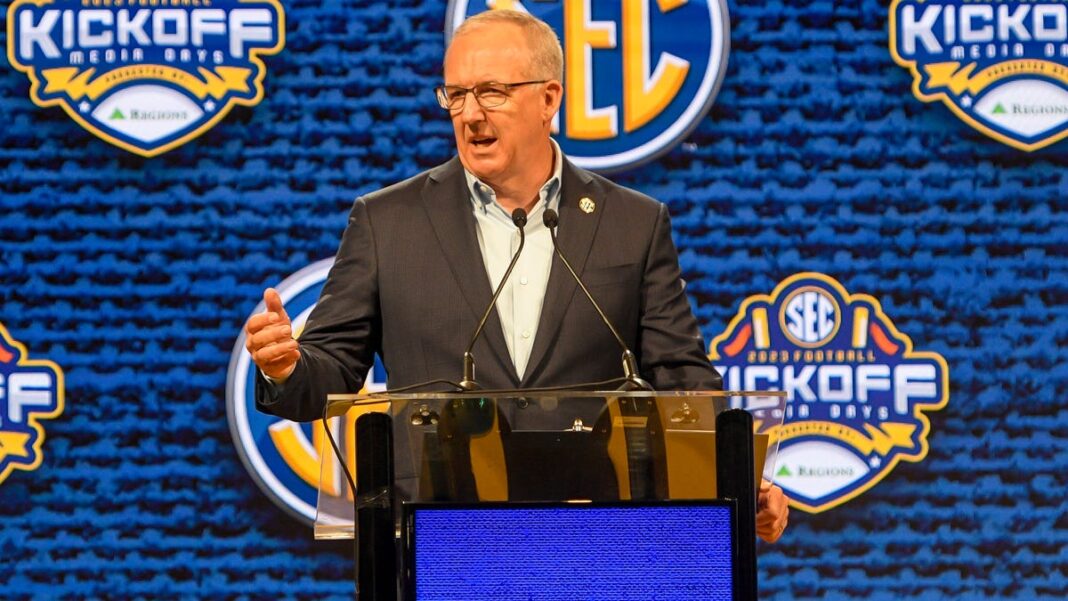The SEC and Big Ten are banking billions as they reshape college football
Earlier this week, SEC commissioner Greg Sankey shared his insights on the Triple Option podcast, providing a glimpse into the trajectory of college football.
If there was any uncertainty, Sankey clarified that the SEC and Big Ten are poised to take control of the situation—and profit immensely from it.
“They aspire to be like us, and it’s their responsibility to figure that out,” Sankey commented. “I won’t lower my standards to accommodate anyone.”
What does this suggest about the NCAA’s long-standing principle of collaborative spirit?
Keep in mind that Sankey’s statements are always deliberate. He is thoughtful in his approach, and his words are chosen carefully.
Therefore, it’s no surprise that this information emerges just before a meeting between SEC and Big Ten officials to strategize their future in college football.
They are set to discuss the repercussions of a recent ruling awarding billions to former players, potential revenue sharing (yes, pay-for-play) possibly starting as soon as the 2025 season, and exploring new revenue possibilities through non-conference games to finance this shift.
Sankey’s comments coincided with the launch of the College Student Football League, proposed as a means to enhance FBS college football and adjust to the evolving legal and political scene.
This proposed league features 136 teams, with 72 in its top division (comprising the current 68 Power conference schools and Notre Dame), and 64 in a lower division—implying potential regulation and promotion between divisions.
However, the likelihood of this league succeeding is similarly slim to that of the XFL.
The concept is predicated on the belief that the SEC and Big Ten will voluntarily share their wealth, which seems unlikely.
When asked on the podcast about being named the “commissioner of college football”—a vague idea of oversight in an incredibly uncooperative organization—Sankey expressed hesitation.
He dismissed the idea of a league like the College Student XFL.
“I’ve looked into it a bit, but I don’t want to reduce the Southeastern Conference to fit into a supposed super league of 70 teams that some people speculate might occur,” Sankey stated.
Face reality, folks.
In an ideal world, college football would reinvent itself to ensure prosperity for all. That’s not going to happen.
Television audiences crave thrilling games and significant stories. Advertisers, who are key to the funding, feel the same way.
They yearn for matchups like Georgia vs. Alabama, Ohio State vs. Oregon, and Michigan vs. Texas—not Alabama facing Western Kentucky or Ohio State against Marshall.
So, would you expect Sankey to approach his 16 university presidents—who are currently facing financial pressures from the House case, upcoming revenue sharing, and upgrading facilities—and suggest the financially irresponsible plan of equal distribution in this College Student whatever it’s called?
Instead of completely distancing themselves from college football, the SEC and Big Ten are advancing and shaping their future. A clean division could invite legal issues and public disapproval.
In response, Sankey and Big Ten commissioner Tony Petitti have crafted a collaborative idea of a “working group” to address “challenges” in college sports. This strategy is elegantly straightforward.
By moving ahead and naturally distancing themselves from the competition, they’re creating a favorable College Football Playoff format and a scheduling advantage with non-conference games that boost media rights revenue—effectively sidelining others.
Who wouldn’t welcome more matchups like Michigan vs. LSU, Ohio State vs. Alabama, and Georgia vs. Penn State in the regular season? Not to mention similar encounters in the CFP.
This evolution has picked up speed since the SEC expanded to 16 teams and the Big Ten increased to 18.
There’s no indication it will slow down soon.

